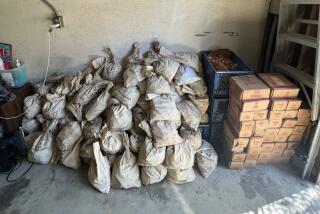Family Tree Yields Plum $20 Bill
- Share via
For decades it was tucked away in a desk drawer, but soon a rare and colorful $20 bill issued to help pay for the Civil War will be in the national spotlight.
“If someone was putting together a complete . . . collection of $20 bills, you’ve got to have this,” said David Sundman, president of Littleton Coin Co. in Littleton, N.H.
The 1866 certificate was discovered this fall when its owner, a man who lives in the Connecticut River Valley of New Hampshire and Vermont, tried to determine the value of old money passed down through his family.
The owner, who wants to remain anonymous, learned he was holding a treasure worth at least $250,000, in Sundman’s estimation.
“I collect large-sized paper money,” Sundman said, “and I was in shock.”
It is one of six known examples of 48,000 such bills circulated between 1865 and 1878 to help finance the Civil War. The series, Sundman said, comprises the rarest $20 bills ever circulated in the country.
“Collectors will be astonished,” he said.
The owner said that when he first asked a couple of dealers to appraise coins and 64 other pieces of 19th century paper money he received, he got conflicting answers. One estimated the collection was worth $1,100. A second “spotted something of great interest” and estimated the value at $2,000, the owner said.
“It just struck me there may be something here worth pursuing,” the owner said, and was referred to Sundman’s company.
“We told them right away, ‘This is a big deal,’ ” Sundman said.
Of the six such bills known to survive, one is in the Smithsonian Institution and another is in the government’s Bureau of Public Debt, Sundman said. Three are in collectors’ hands. The latest is in Littleton’s vault, awaiting auction next spring.
A similar $20 bill discovered last year sold at auction for $528,000, he said.
The bill is a gold certificate, meaning it was redeemable from the U.S. Treasury for $20 in gold. It is 50% larger and more colorful than today’s currency. The front depicts an eagle perched on a Union shield, symbolizing the fight to preserve the Union, Sundman said.
By the grading system used by collectors, the bill is in very fine to extra fine condition, Sundman said. It has a few small edge splits along the bottom margin and a few tiny pinholes, and the colors are fresh and bright.
The owner is the fourth generation in his family to own the bill. It came into the family through a great-grandfather who was a New York banker.
The owner received it within the last year from his mother, who had kept it in a leather pouch in her desk in the New York area.
When Littleton called to tell the owner the note was worth at least a quarter of a million dollars, he stayed calm--briefly.
“When I got off the phone, I asked my fiancee, ‘What do you think that bill might be worth?’ She guessed $2,000, and I said, ‘Higher.’
“ ‘$3,000.’
“ ‘Higher.’
“ ‘$10,000.’
“ ‘Higher.’
“That went on for a while and I couldn’t do it any longer,” he said. “I told her, and she just jumped up and down.”
The find was exciting even for Sundman, no stranger to rare money.
“You see rare things, but they are usually in dealers’ cases and they’ve got big prices on them,” he said. “You don’t often make a discovery of something that is previously unknown.”
The note will be auctioned the first week of March at the Chicago Paper Money Exposition, one of the largest paper money events in the world.
More to Read
Sign up for Essential California
The most important California stories and recommendations in your inbox every morning.
You may occasionally receive promotional content from the Los Angeles Times.













